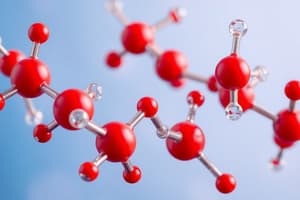Podcast
Questions and Answers
What is a monomer?
What is a monomer?
A building block of a macromolecule; a small chemical unit that makes up a polymer.
What is a polymer?
What is a polymer?
A molecule composed of many monomers.
What is a monosaccharide?
What is a monosaccharide?
The monomer of carbohydrates, a single sugar molecule.
What is a disaccharide?
What is a disaccharide?
What is a polysaccharide?
What is a polysaccharide?
What is glucose?
What is glucose?
What is glycerol?
What is glycerol?
What are fatty acids?
What are fatty acids?
What is a triglyceride?
What is a triglyceride?
What is a phospholipid?
What is a phospholipid?
What is a steroid?
What is a steroid?
What is cholesterol?
What is cholesterol?
What are hormones?
What are hormones?
What are amino acids?
What are amino acids?
What is a nucleotide?
What is a nucleotide?
What is a carbohydrate?
What is a carbohydrate?
What is a lipid?
What is a lipid?
What is a protein?
What is a protein?
What are nucleic acids?
What are nucleic acids?
What is an enzyme?
What is an enzyme?
What does it mean to denature an enzyme?
What does it mean to denature an enzyme?
Flashcards are hidden until you start studying
Study Notes
Macromolecules Overview
- Macromolecules are large, complex molecules essential for biological functions, categorized into carbohydrates, lipids, proteins, and nucleic acids.
Monomers and Polymers
- Monomer: The basic unit that serves as a building block of a macromolecule.
- Polymer: A molecule consisting of many monomers bonded together, forming macromolecules.
Carbohydrates
- Monosaccharides: The simplest form of carbohydrates, single sugar molecules (e.g., glucose).
- Disaccharides: Carbohydrates formed by the linkage of two monosaccharides.
- Polysaccharides: Complex carbohydrates made of many linked sugar molecules.
- Basic formula: Carbohydrates consist of carbon, hydrogen, and oxygen in a 1:2:1 ratio (CH2O).
Lipids
- Lipids: Macromolecules containing carbon, hydrogen, and oxygen, primarily insoluble in water. Types include fats, oils, waxes, and steroids.
- Glycerol: A three-carbon molecule forming the backbone of triglycerides and phospholipids.
- Fatty Acids: Long carbon chains. Saturated fats contain only single bonds, while unsaturated fats contain at least one double bond.
- Triglycerides: Lipids composed of one glycerol and three fatty acids.
- Phospholipids: Comprised of one glycerol, one phosphate group, and two fatty acids. Critical for cell membranes.
- Steroids: Organic compounds with a structure of four carbon rings, functioning primarily as chemical messengers.
- Cholesterol: A lipid present in animal tissues, important for cellular structure and function.
Proteins
- Proteins: Made of amino acids, contain carbon, hydrogen, oxygen, nitrogen, and sometimes sulfur and phosphorus.
- Amino Acids: The building blocks of proteins; animal proteins are complete, containing all 20 amino acids, while many plant proteins are incomplete.
- Enzymes: A type of protein that catalyzes biochemical reactions, critical for metabolic processes.
- Denaturation: A process where enzymes lose structure and function due to extreme temperature or pH changes.
Nucleic Acids
- Nucleic Acids: Includes DNA and RNA, composed of nucleotides.
- Nucleotide: The monomer of nucleic acids, consisting of a phosphate group, a five-carbon sugar, and a nitrogenous base.
- DNA stores genetic information, with sequences of adenine, guanine, cytosine, and thymine determining inherited characteristics.
Hormones
- Hormones: Proteins functioning as chemical messengers in the body, regulating various physiological processes.
Studying That Suits You
Use AI to generate personalized quizzes and flashcards to suit your learning preferences.



